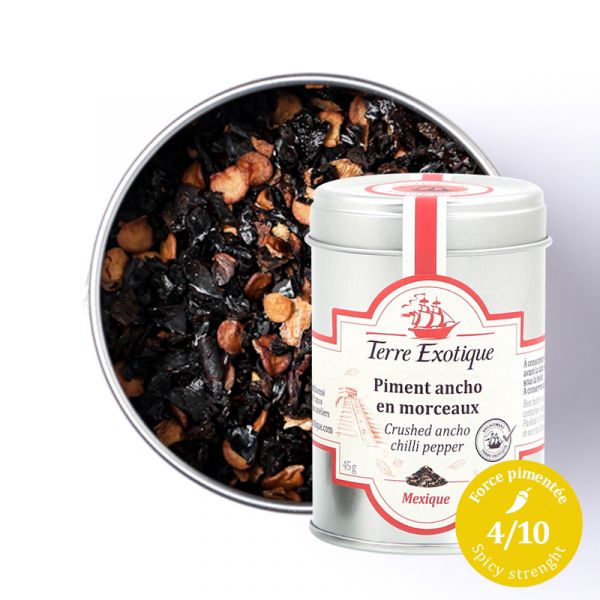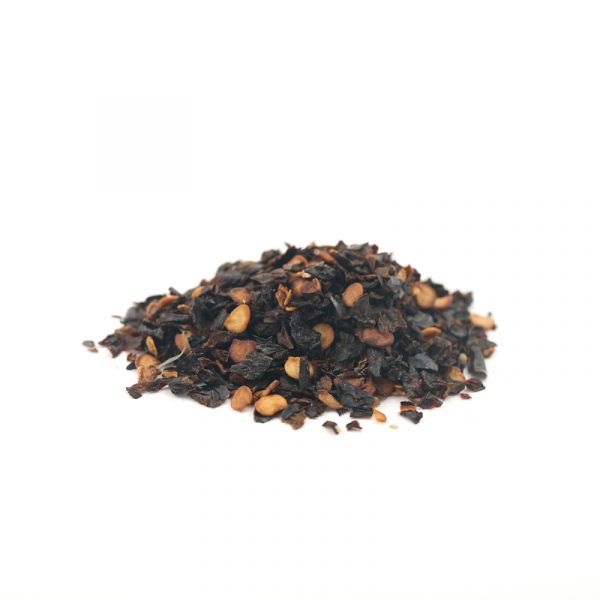



How to Use Ancho Pepper in Cooking?
Some Ideas for Using Ancho Pepper
The mildness of Ancho pepper makes it easy to use in cooking. It will awaken your taste buds, adding a burst of flavor and a touch of originality to your dishes.
You can use it to accompany both red and white meats or delicately accentuate fish and seafood.
Ancho pepper in pieces is also commonly used in traditional Mexican dishes and complements sauces and slow-cooked dishes perfectly.
It can also be added at the end of cooking to dishes like rice, pasta, or potatoes. In soups and veloutés, Ancho pepper will add character.
In short, it will bring a touch of originality to a traditional Mexican dish, gazpacho, soup, marinade for grilling, fish in parchment paper, creamy sauce, homemade hummus, or even a summer salad.
The Aromas of Ancho Pepper
Ancho pepper is a mild pepper with surprising and distinctive flavors of licorice, raisins, and even cocoa, delighting the palate.
It is a highly aromatic pepper that adds character to your dishes.
Its spiciness level is 3/10 (mildly spicy) on the Scoville scale, as it is low in capsaicin. It is milder than Espelette pepper, making it suitable for both adults and children.
Ancho Pepper, a Delicate Pepper
Botanical Origin of Ancho Pepper
Ancho pepper belongs to a variety called Capsicum annuum, like Jalapeno pepper or Chipotle pepper. It falls under the category of sweet peppers.
How do Ancho Peppers Grow?
Ancho pepper is a dried and dehydrated pepper. When fresh, it is known as Poblano pepper and can measure up to 15 cm long and 8 cm wide. However, once dried, it loses its length while retaining its width. Thus, Mexicans refer to it as Ancho pepper, which means "wide pepper." The cultivation of this pepper requires high temperatures and plenty of sunlight. Therefore, it is harvested relatively late in the season. To dry it, the pepper is exposed to the sun for several weeks.
What is the Origin of Ancho Pepper?
This sweet pepper originates from the state of Puebla, Mexico. Puebla is located southeast of Mexico City. However, it is now widely known and appreciated throughout the American continent. It has been widely used in cooking there for about two decades.
The History of Ancho Peppers
Ancho pepper is a flagship pepper in Mexican culture. Even before the Spanish conquest, it was frequently used in traditional Mexican and South American cuisine. In Mexico, it is often used in combination with pasilla and mulato peppers. These three peppers are essential in traditional sauce recipes.
Click here to learn more about peppers
| Allergen | Absence |
|---|---|
| Native country | MEXIQUE |
| Genus and botanical species | Capsicum annuum |
| Ingredients | ancho chili |
| Nutritional Info | VN Energie pour 100 g (energy for 100g) : 1526 kJ / 366 kcal VN Matière grasse (fat) : 12 g Dont acide gras saturés (of which saturated fat) : 2 g VN Glucides (carbohydrate) : 21 g Dont sucres (of which sugars) : 19 g VN Protéines (protein) : 15 g Vn Sel (salt) : 0.1 g |
| TRACES EVENTUELLES D'ALLERGÈNES | céleri, sésame, moutarde, fruits à coques. |
 Français
Français 